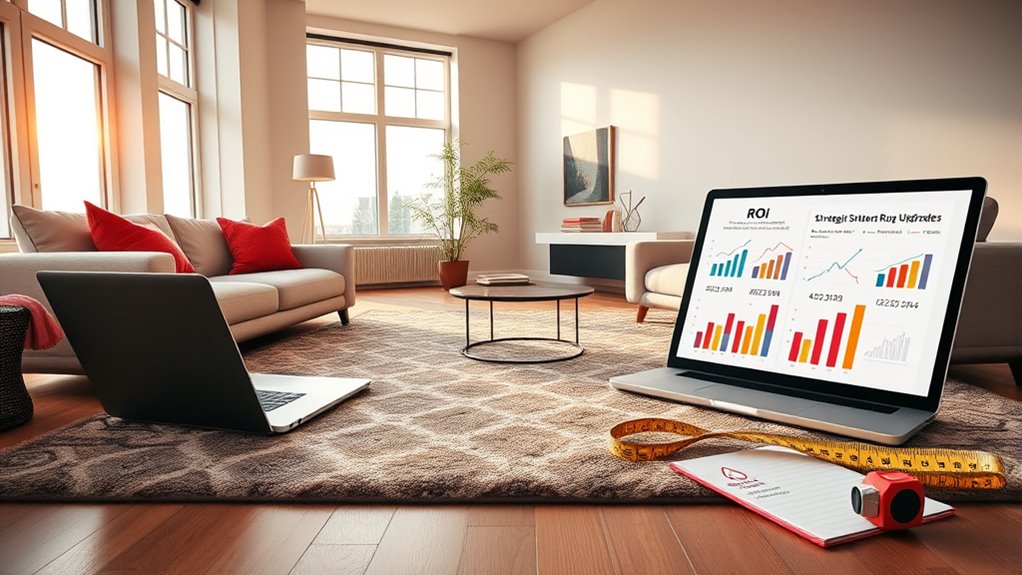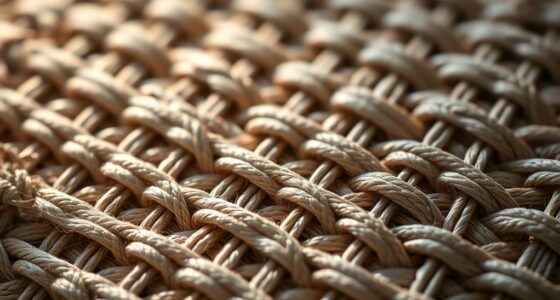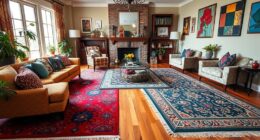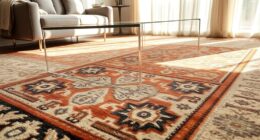To calculate ROI on rug upgrades for your rentals or Airbnb, start by estimating the upfront costs, including materials, installation, and maintenance. then compare this with the potential increase in rental income and occupancy rates from improved guest satisfaction. Divide the total investment by monthly revenue gains to find your payback period. If you’d like tips on maximizing your investment and understanding long-term benefits, keep exploring further.
Key Takeaways
- Determine total upgrade costs, including purchase, installation, and maintenance, to establish initial investment.
- Estimate potential increase in rental income or occupancy rates resulting from improved aesthetics and guest satisfaction.
- Calculate the payback period by dividing total costs by monthly revenue gains attributable to the rug upgrade.
- Assess the durability and lifespan of rug materials to project long-term costs and replacement frequency.
- Compare ongoing maintenance expenses against revenue benefits to evaluate overall return on investment over time.
Estimating the Initial Cost of Rug Upgrades

Estimating the initial cost of rug upgrades begins with understanding the size of your rental or Airbnb property and the quality of the rugs you choose. Larger areas require more material and will naturally cost more. For example, a small bedroom might need a low-cost, basic rug, while a spacious living room calls for a higher-quality, more durable option. The quality of the rug impacts its price—premium materials like wool or designer brands cost more upfront but last longer and look better over time. Don’t forget to factor in additional costs such as padding, delivery, and installation if needed. Additionally, considering furniture and decor styles can help you select rugs that complement your space and appeal to guests, enhancing your property’s attractiveness. By considering these elements, you’ll get a clear picture of your initial investment, setting a solid foundation for evaluating potential returns.
Determining the Expected Increase in Rental Income
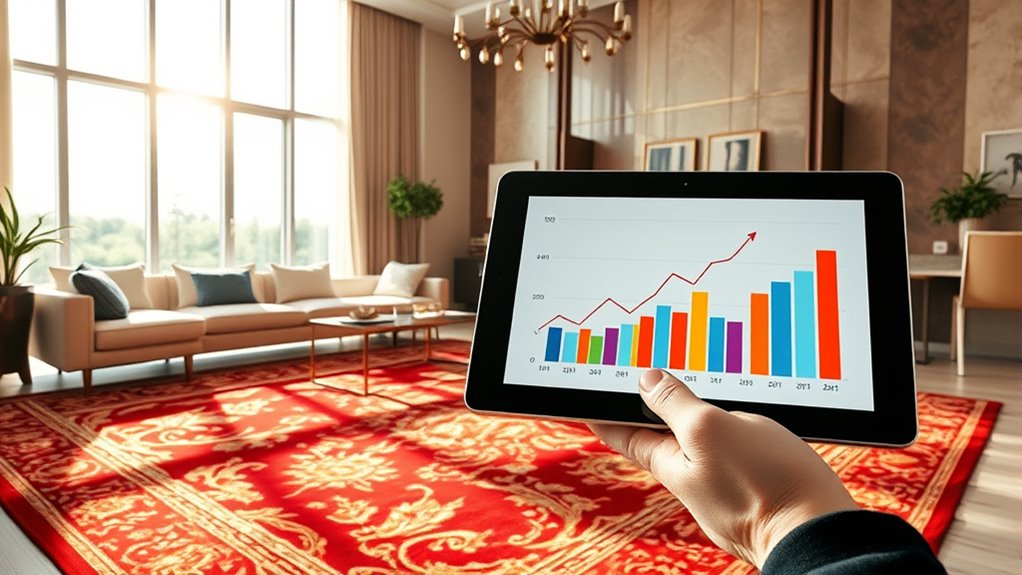
Understanding how rug upgrades can boost your rental income involves appraising what tenants or guests value most. Consider factors like style, comfort, and cleanliness, which can influence their choice. Research comparable rentals in your area to see if upgraded rugs correlate with higher nightly rates or longer stays. You can also analyze guest reviews to identify if flooring is a common praise point or complaint. Additionally, test the waters by adjusting your rental prices after upgrades to see if there’s a noticeable increase in bookings or revenue. Keep in mind that the appeal of a fresh, modern rug can make your property stand out, allowing you to charge a premium. Incorporating color and style considerations that appeal to your target market can further enhance the perceived value of your property. By appraising these indicators, you’ll better estimate how much your rental income could rise with new rugs.
Analyzing the Impact on Guest Satisfaction and Reviews
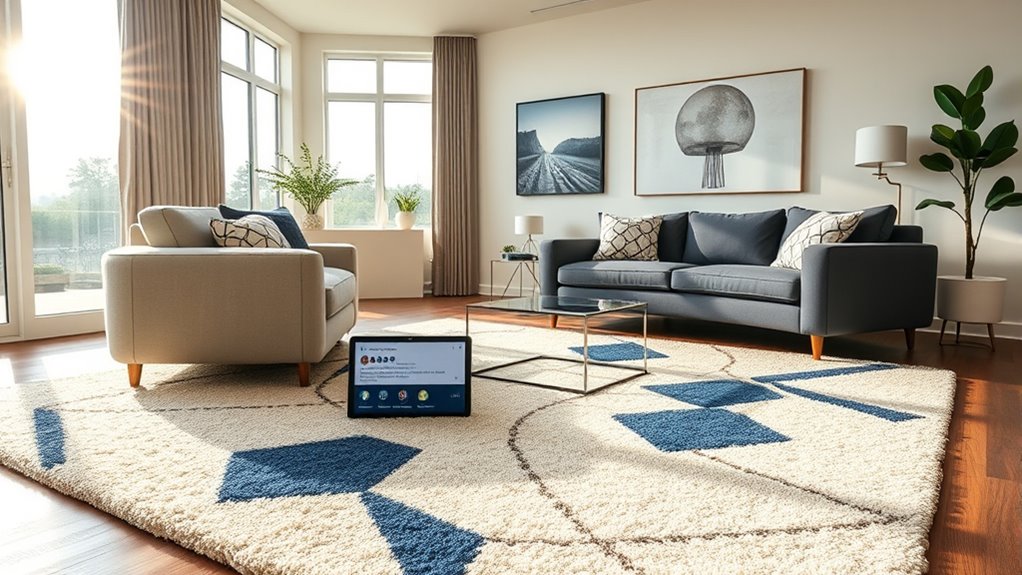
Upgrading your rugs can considerably boost guest satisfaction by enhancing comfort and creating a cozy atmosphere. Improved visual appeal makes your space stand out in reviews and encourages positive feedback. Plus, unique or stylish rugs help your property differentiate itself from competitors, attracting more bookings. Incorporating a calming environment through thoughtful decor choices like rugs can also promote relaxation and well-being for your guests.
Comfort Enhancement Benefits
When you invest in new rugs for your rental or Airbnb, you directly influence your guests’ comfort and overall experience. A soft, plush rug creates a cozy atmosphere, making guests feel more at home. It also provides a comfortable surface for walking, lounging, or sitting, which can improve their overall satisfaction. Guests notice the physical comfort of your space, and it often translates into positive reviews. Comfortable rugs can reduce noise and foot traffic impact, making the environment quieter and more relaxing. When guests feel comfortable, they’re more likely to leave favorable feedback and recommend your property. Additionally, incorporating diverse learning styles in your space, such as textured rugs, can further enhance guest engagement. Ultimately, these comfort benefits lead to higher guest satisfaction, better reviews, and increased chances of repeat bookings.
Visual Appeal Improvements
Enhancing the visual appeal of your rental or Airbnb with attractive rugs can considerably boost guest satisfaction and lead to better reviews. Well-chosen rugs add warmth, color, and style, making the space feel more inviting and thoughtfully curated. They can hide imperfections on flooring and create a cohesive look that aligns with your decor theme. When guests notice a stylish or high-quality rug, they often perceive the space as more comfortable and luxurious, encouraging positive feedback. Additionally, attractive rugs can elevate the overall ambiance, making your property stand out in photos and online listings. Incorporating rustic decor elements through your rugs can strengthen the farmhouse aesthetic and appeal to guests seeking a cozy, countryside experience. This increased visual appeal can lead to higher ratings, repeat bookings, and word-of-mouth recommendations, all of which contribute to your return on investment.
Differentiation Advantage
A well-chosen rug can set your rental or Airbnb apart from competitors by creating a distinctive and memorable space. When guests notice thoughtful details like a stylish rug, it signals quality and care, boosting their overall impression. This visual appeal can lead to higher satisfaction and more positive reviews, as guests feel they’re staying somewhere unique and welcoming. A standout rug not only enhances the aesthetic but also adds comfort, making guests more likely to relax and enjoy their stay. Over time, these positive experiences can translate into repeat bookings and glowing feedback, increasing your property’s reputation. Ultimately, investing in a quality rug isn’t just about looks—it’s about creating an environment that leaves a lasting impression and gives you a competitive edge.
Calculating the Payback Period for Your Investment

Calculating the payback period is essential to determine how quickly your rug upgrade will start generating a return on investment. To do this, estimate the total cost of the rug upgrade, including purchase, installation, and any maintenance. Next, identify the additional revenue or savings the upgrade will bring, such as higher rental rates, increased occupancy, or reduced turnover costs. Divide the total investment by the monthly increase in income or savings. The result shows how many months it will take to recoup your initial expenditure. A shorter payback period indicates a quicker return, helping you prioritize upgrades that offer faster benefits. Keep in mind, this calculation assumes consistent performance, so consider factors like seasonal demand or market fluctuations. Incorporating AI-driven analytics can further refine your projections by providing more accurate insights into demand patterns and potential revenue increases.
Comparing Costs and Benefits Across Different Rug Options

When comparing rug options, you need to consider material durability and cost to ensure your investment holds up. Think about how style and appeal can attract guests and boost your rental’s vibe. Also, assess the rug’s longevity and how often you’ll need to replace it to maximize your ROI. Incorporating material durability into your decision-making process helps ensure that the rug will withstand regular wear and tear, especially in high-traffic rental environments.
Material Durability and Cost
Choosing the right rug for your rental or Airbnb hinges on understanding how material durability influences long-term costs. Durable materials resist wear, stains, and damage, reducing replacement frequency and maintenance expenses. For example, synthetic fibers like nylon are affordable and resilient, while natural fibers such as wool offer longevity but come with higher initial costs. Here’s a quick comparison:
| Material | Cost Range | Durability Level | Ideal For |
|---|---|---|---|
| Nylon | Low | High | High-traffic areas |
| Wool | High | Very High | Luxury or low-traffic areas |
| Polyester | Very Low | Moderate | Budget-friendly spaces |
| Polypropylene | Low | Moderate | Rental properties |
Investing in durable materials saves money over time, making your rug a smart, cost-effective upgrade. Additionally, understanding material durability can help you select options that minimize ongoing costs and enhance guest satisfaction.
Style and Appeal Impact
The style and appeal of your rug can substantially influence your rental or Airbnb’s overall vibe, attracting different guest demographics and justifying varied price points. A modern, sleek rug can appeal to young professionals seeking a contemporary look, while a plush, patterned rug might attract families looking for comfort. The color scheme and design should complement your space’s decor and set the right mood. Investing in eye-catching rugs can elevate the room’s aesthetic instantly without major renovations. While pricier, designer rugs often draw higher-paying guests and boost perceived value. Conversely, simpler or more affordable options may still enhance appeal if they match your space’s style. Carefully selecting rugs that align with your target audience can maximize your investment by increasing occupancy rates and allowing for higher rental prices. Additionally, choosing a rug that reflects dog breeds or pet-friendly features can attract pet owners, expanding your potential guest base.
Longevity and Replacement
Considering the durability and replacement costs of your rug is essential for maximizing your rental or Airbnb’s ROI. Different rug options vary markedly in lifespan, affecting your long-term expenses. High-quality wool rugs may last decades, making them a cost-effective investment despite a higher upfront price. Conversely, synthetic or lower-grade rugs might be cheaper initially but require replacement every few years, increasing ongoing costs. When comparing options, calculate the total cost over the expected lifespan—dividing the purchase price by the number of years it remains in good condition. Additionally, consider the wear and tear your space endures; high-traffic areas demand more durable rugs. Balancing initial costs with longevity ensures you select a rug that offers the best value, minimizes replacement frequency, and boosts your ROI over time.
Considering the Longevity and Maintenance Expenses of Rugs
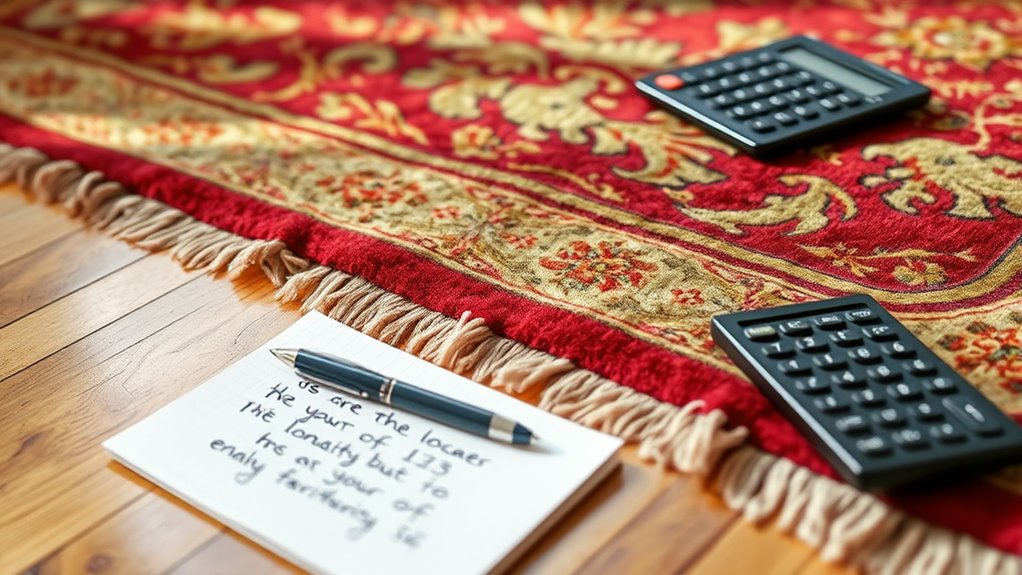
When evaluating rug upgrades for your rental or Airbnb property, maintaining their longevity and upkeep costs is vital. Rugs with durable materials and tight weaves tend to last longer, reducing replacement frequency and expenses. Regular cleaning, such as vacuuming and prompt stain removal, extends their lifespan and keeps them looking fresh. Consider investing in professional cleaning services periodically, which can prevent dirt buildup and fiber damage. Keep in mind that certain styles or fibers may require special maintenance, impacting costs over time. Budgeting for ongoing cleaning and minor repairs ensures your rug remains attractive without unexpected expenses. Ultimately, understanding the long-term maintenance requirements helps you make smarter choices, balancing upfront costs with the savings gained from a longer-lasting, well-maintained rug.
Evaluating the Effect of Rug Improvements on Occupancy Rates

Upgrading rugs in your rental or Airbnb can markedly influence occupancy rates by enhancing the overall aesthetic and comfort of your property. Better rugs create a welcoming atmosphere that guests notice immediately, boosting their desire to stay longer. To evaluate their impact, consider these key factors:
Upgrading your rugs can boost bookings by enhancing comfort and visual appeal.
- Guest Feedback: Positive reviews often mention comfort and style, directly tied to rug quality.
- Booking Trends: Increased occupancy during seasons when your upgraded rugs stand out.
- Visual Appeal: High-quality rugs can differentiate your property from competitors, attracting more bookings.
Incorporating Tax Benefits and Incentives

Taking advantage of tax benefits and incentives can substantially boost the return on your rug upgrades by lowering your overall expenses. Many regions offer deductions, credits, or rebates for investments that improve energy efficiency or enhance property value. For example, if your rug upgrade qualifies as a capital improvement, you might be able to depreciate its cost over several years, reducing taxable income. Additionally, some local programs provide incentives for renovations that improve safety or sustainability. Be sure to document all expenses thoroughly and consult with a tax professional to maximize your benefits. Incorporating these incentives into your ROI calculations can make rug upgrades more financially attractive, ultimately increasing your profitability and helping you recover costs faster.
Monitoring and Adjusting Your ROI Strategy Over Time

Tracking the results of your rug upgrades allows you to see how your investment performs over time. Regular monitoring helps you identify what’s working and what isn’t, so you can make informed adjustments. Consider these key steps:
- Review occupancy rates and rental income monthly to see if your upgrades attract more guests.
- Analyze guest feedback to understand their experience and identify areas for improvement.
- Compare expenses versus returns quarterly to ensure your ROI remains positive and adapt your strategy if needed.
Frequently Asked Questions
How Do Seasonal Changes Affect Rug Maintenance Costs?
Seasonal changes can considerably impact your rug maintenance costs. For example, in autumn and winter, you’ll likely face more dirt, mud, and moisture tracked inside, increasing cleaning frequency and potential damage. During spring and summer, higher foot traffic from guests or family can lead to quicker wear and dirt buildup. You might need to invest more in deep cleaning and repairs during colder months, balancing your maintenance budget accordingly.
What Are the Best Rug Materials for High-Traffic Rental Properties?
Did you know that high-traffic areas experience up to 60% more wear and tear? For rental properties, choose durable rug materials like nylon or polypropylene, which resist stains, fading, and crushing. These synthetic options are budget-friendly and easy to clean, making them ideal for busy spaces. You’ll save on replacement and maintenance costs over time, ensuring your rental stays attractive and functional without constant upgrades.
How Can I Measure Improvements in Guest Satisfaction From Rug Upgrades?
You can measure improvements in guest satisfaction from rug upgrades by collecting direct feedback through surveys or reviews. Pay attention to comments related to comfort, cleanliness, and aesthetics. Track changes in overall ratings before and after upgrades, and monitor repeat bookings or extended stays, as these often indicate higher satisfaction. Analyzing these data points helps you understand how your rug improvements positively impact guest experiences.
Are There Specific Tax Incentives for Upgrading Rental Property Rugs?
Oh, sure, because Uncle Sam just loves giving out freebies for replacing rugs, right? In reality, there are no specific tax incentives solely for upgrading rental property rugs. However, you might deduct the cost as a repair or maintenance expense if it keeps the property in good condition. Always check with a tax pro, because rules can be tricky, and you don’t want to miss out on any deductions.
How Often Should Rug Replacements Be Scheduled to Maximize ROI?
You should plan to replace rugs every 3 to 5 years to maximize ROI. Regular replacements keep your rental appealing and fresh, attracting more tenants or guests. Keep an eye on wear and tear—if rugs show significant damage or stains sooner, consider sooner replacements. Consistent updates not only boost your property’s appeal but also help prevent long-term damage, ensuring your investment stays valuable and competitive in the rental market.
Conclusion
By carefully calculating each factor, you’ll uncover the true potential of your rug upgrades. But remember, the real question isn’t just about initial costs or immediate gains—it’s what happens as guest expectations evolve. Will your investment continue to pay off long-term? Stay attentive, monitor your results, and adapt your strategy. The next move could make or break your rental’s success—are you ready to find out what’s next?
